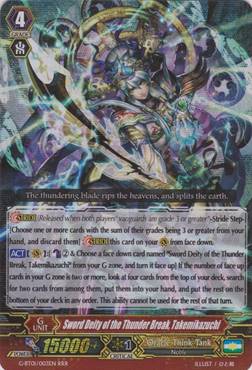|
|
|||||
| Pojo's Cardfight!! Vanguard news, tips, strategies and more! | |||||
 |
|||||
|
|
|||||
|
Pojo's Cardfight Vanguard Site
This Space |
Saikyo Cardfighter R
on Cardfight!! Vanguard
Soft Advantage 4 LIEF, Yo
The most subtle way to take cards away or get some of your
own is probably the best way.
If I were suddenly so inclined, I would probably run some
sort of G1 rush deck if for whatever reason I couldn’t use
what I currently have. Only one thing really turns me off
it, apart from effort building it, and that I really don’t
like to think about how consistent it would be without
someone else collaborating so we get the same results. They
work on assassination by turn 4 and if they fail then you’re
pretty fucked.
Primarily, the reason they work so well is that they tend to
still scale to make the 16k columns, but they have an
advantage normal decks do not have. Normal decks have to
spend the first 3 turns riding, so for the first bit of it,
they are restricted in terms of guard, making it the perfect
opportunity to hit them for damage they cannot block. G1
decks only need to ride once and so they waste no more
shield riding up and can quickly set up a board.
I believe that damage is worth more than cards, and G1 rush
decks take this to an extreme by running 16 Critical: they
work by a fast kill and seek to have a big damage gap so
Heals are useless. I swear by 12 in most of mine but if
strong enough cause is given for me to run 16, I may. Think
about it. If I can quickly accelerate damage and/or threaten
them with some more, they have to then spend more guard
trying to not die, and each guardian used either means one
less rear-guard to worry about or less guard to block my
truly meaty attacks. It all comes down to the soft
advantage.
When I say soft advantage, I mean plays or mechanics that
don’t give a straight-up plus to you, but can threaten to do
that much based on how the game works. This is something I
combine to good effect in my own decks, and is largely the
reason why I stuck with Kagero and Narukami.
You see, both of them work to blow up enemy cards for a
cost. That’s the source of your HARD advantage. Where the
soft advantage comes in later is when the opponent no longer
has backup attackers and boosters. They attack weakly or in
good cases don’t attack at all. This in turn saves cards in
your hand you would otherwise have used guarding. That’s the
SOFT advantage.
But as the title ought to have told you, I’m totally all for
soft advantage whenever possible. The reason for this is
because of the way soft advantage is costed compared to hard
advantage. Anything that can increase a gap in card
advantage tends to be for a clear price, usually
Counterblast 1 for a +1. Soft advantage on the other hand
tends to be costed differently because they may not force
the same advantage out of the opponent. And it can be
deceptively cheap.
I don’t think a hard plus can actually be strictly called a
real plus anymore. Calling something to the board kind of
restricts it to one use and adding to the hand, especially
randomly like drawing, tends to fluctuate in quality. Card
quality is definitely more important than quantity in my
mind. You know how Draw Triggers add 5k shield to your hand
on average when checked and are also 5k shield themselves.
When guarding against a 16k column you therefore either need
to spend two 5ks or one 10k. I’d rather lose the one 10k.
It’s more cost efficient.
It basically all comes down as to whether any hard advantage
you gain can be translated into some sort of worthwhile
investment. If you look at a Shadow Paladin deck, especially
the modern ones, they plus and then use it to do…whatever
the hell they want with it. Sack it to force more out the
opponent’s hand through pressure, add to your own, replace
with a higher quality card, you name it. They take what they
gain and turn it into something else, which to me is worth
more than just a straight +2 to field or hand.
The soft advantage that is damage is also primarily why I am
so aggressive when playing Vanguard and why my bread and
butter is retire: because I appreciate the numbers going
into it. I didn’t do every single bit of math off the top of
my head, because I’m not a fucking wizard, but from what I
gathered I knew the game was basically going to boil down to
whether or not you could match or equal whatever advantage
the opponent can gain. Hard advantage-wise, retire takes
away more cards than they gain on average, and damage
forcing guard only adds to this problem the opponent has.
Victory lies in the subtle gains over the course of several
turns. It needs to at the very least match the amount of
shield gained by the opponent compared to the shield they
take away from you. I’m pretty sure I’m the only guy at my
own locals who thinks this way and so I tend to win a lot.
I am of course aware that a deck cannot realistically rely
on just either hard or soft advantage to survive (save for
some very extreme exceptions like Spike Brothers), because
remember, if you call a card, you’re effectively sacrificing
that unit’s shield value to have something to attack with.
Therefore, if you fight a deck based on manipulating the
cards you have on the board, it’s going to get positively
shat on, because they’re using your resources for THEIR
gain. Therefore, if you can spare any G1 or 2 that can give
you hard +1s then they’re welcome, but that’s really only
because of how important rear-guards are in that deck. All
the same, throughout the history of Vanguard anything that
gains soft advantage such as re-standers or Turn 3 on-hit
effects tend to be the ones that do better because of how
they’re costed so cheaply compared to hard plusses, which
Bushiroad seem to value more. So I’ll leave you with the
advice that you ought to abandon what you knew about the
TCGs you used to play because Vanguard farts in the general
direction of those concepts.
Talk to me about something else that’s either hard or soft,
you pervert, at
saikyocardfighter@outlook.com
|
||||
|
Copyrightę 1998-2017 pojo.com This site is not sponsored, endorsed, or otherwise affiliated with any of the companies or products featured on this site. This is not an Official Site. |
|||||

